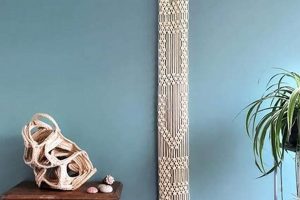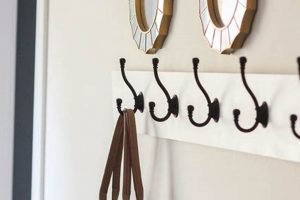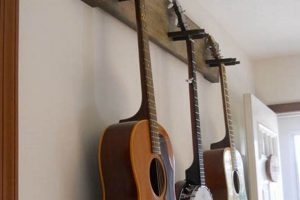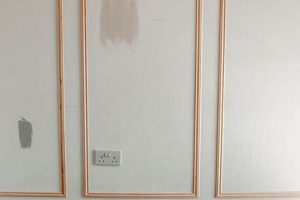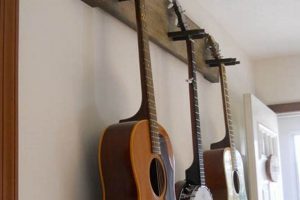The creation of a self-made support system for stringed instruments, specifically guitars, designed to be mounted on a vertical surface, offers a practical storage solution. An example of this involves repurposing common materials, such as wooden planks and metal hooks, to construct a secure and visually appealing fixture for suspending the instrument.
This approach to instrument storage presents several advantages. It maximizes available floor space, protects the guitar from accidental damage, and can serve as a decorative element within a room. Historically, musicians have sought innovative methods to safeguard their instruments, leading to the development of diverse support structures. Furthermore, the self-sufficiency aspect fosters a sense of personal connection with both the instrument and the environment in which it is housed.
The subsequent sections will delve into the specific materials required, step-by-step construction techniques, safety considerations, and customization options relevant to the fabrication of a personalized guitar storage solution.
Essential Considerations for Self-Constructed Guitar Mounts
The creation of a secure and reliable guitar mounting system necessitates meticulous planning and execution. The following points outline critical factors to ensure both the safety of the instrument and the longevity of the mounting apparatus.
Tip 1: Material Selection: Employ hardwoods such as oak or maple for the support structure to ensure adequate load-bearing capacity. Softwoods, while easier to work with, may lack the necessary strength to reliably support the weight of a guitar over an extended period.
Tip 2: Secure Wall Anchoring: Utilize appropriate wall anchors designed for the specific wall type (drywall, plaster, concrete). Incorrect anchoring can lead to catastrophic failure and potential damage to the instrument.
Tip 3: Protective Padding: Implement a non-reactive padding material, such as felt or soft leather, at all points of contact between the mount and the guitar’s finish. This prevents scratches, dents, and potential chemical reactions that could degrade the instrument’s aesthetic value.
Tip 4: Weight Distribution Analysis: Prior to installation, assess the weight distribution of the guitar and strategically position the mounting points to evenly distribute the load. This minimizes stress on specific areas of the mount and the guitar’s neck.
Tip 5: Regular Inspection: Conduct routine inspections of the mounting hardware and the support structure for signs of wear, loosening, or damage. Address any identified issues promptly to maintain the integrity of the system.
Tip 6: Neck Support Considerations: When designing the mount, account for the guitar’s neck angle and ensure the support is configured to provide adequate support without placing undue pressure on the headstock.
Adherence to these guidelines will contribute significantly to the creation of a robust and dependable system for suspending guitars. Prioritizing safety and durability is paramount in safeguarding valuable musical instruments.
The subsequent section will address advanced design techniques and aesthetic considerations for enhancing the functionality and visual appeal of the guitar mounting system.
1. Stability
Stability, in the context of a self-constructed guitar mounting system, refers to the fixture’s ability to reliably support the weight of the instrument over an extended period, preventing collapse or detachment from the wall. This attribute is paramount for safeguarding valuable musical instruments from potential damage.
- Material Strength and Load Capacity
The selection of appropriate construction materials directly influences stability. Utilizing hardwoods like oak or maple, known for their high tensile strength, ensures the hanger can withstand the sustained load of a guitar. Conversely, using weaker materials can compromise stability and lead to structural failure over time. A hanger constructed from a material not rated for the guitar’s weight could detach.
- Secure Wall Anchoring Techniques
The method of attaching the hanger to the wall is critical for stability. Employing wall anchors designed for the specific wall type (drywall, plaster, concrete) is essential. Improper anchoring can result in the hanger pulling away from the wall, potentially causing the instrument to fall. Anchoring systems must match both the wall material and the expected load.
- Weight Distribution and Support Design
The design of the hanger must consider the guitar’s weight distribution. The mounting points should be positioned to evenly distribute the load, preventing undue stress on any single point. An asymmetrical design that concentrates weight on one side can compromise the hanger’s overall stability and increase the risk of failure.
- Joint Integrity and Construction Methods
The integrity of the joints within the hanger’s construction is vital for maintaining stability. Properly executed joinery techniques, such as mortise and tenon or dovetail joints, enhance the structural integrity of the unit. Weak or poorly executed joints can become points of failure under sustained load, ultimately compromising the hanger’s stability.
These facets of stability are intrinsically linked in the design and implementation of a self-made guitar mounting system. Neglecting any of these aspects can compromise the hanger’s ability to reliably support the instrument, underscoring the importance of a holistic approach to ensuring stability. A well-designed, properly constructed, and securely anchored hanger provides a safe and stable storage solution for guitars.
2. Materials
The selection of appropriate materials is paramount in the successful construction of a self-fabricated guitar mounting system. The composition, structural properties, and surface characteristics of chosen materials directly influence the safety, durability, and aesthetic appeal of the finished product.
- Hardwood Selection and Load-Bearing Capacity
Hardwoods, such as oak, maple, and walnut, offer superior strength and rigidity compared to softwoods. Their dense cellular structure provides enhanced resistance to bending and deformation under load, making them ideal for supporting the weight of a guitar. The choice of hardwood species should align with the instrument’s weight and the desired lifespan of the hanger. For instance, a heavier bass guitar would necessitate a more robust hardwood than a lightweight acoustic guitar.
- Metal Components: Hooks, Brackets, and Fasteners
Metal components, including hooks, brackets, and fasteners, provide crucial structural support and connection points within the hanger system. The choice of metal (steel, aluminum, brass) should be based on its tensile strength, corrosion resistance, and compatibility with the chosen wood. Steel offers exceptional strength, while brass provides aesthetic appeal and corrosion resistance. The size and type of fasteners (screws, bolts) must be appropriate for the load being supported and the thickness of the materials being joined.
- Padding and Protective Linings
Padding materials, such as felt, cork, or leather, serve to protect the guitar’s finish from scratches, dents, and chemical reactions. These materials should be non-reactive and non-abrasive to prevent damage to the instrument’s lacquer or varnish. The thickness and density of the padding should be sufficient to cushion the guitar without compressing excessively, which could lead to pressure points. Inappropriate padding materials, like some synthetic rubbers, could damage the guitar’s finish over time.
- Adhesives and Joining Agents
Adhesives play a crucial role in bonding wooden components, creating a strong and durable structure. The type of adhesive used (wood glue, epoxy, polyurethane glue) should be selected based on its bonding strength, water resistance, and curing time. Wood glue is generally suitable for interior applications, while epoxy or polyurethane glue offers superior water resistance for humid environments. Proper surface preparation and clamping pressure are essential for achieving a strong and reliable bond.
The deliberate and informed selection of materials directly influences the overall effectiveness of a self-constructed guitar mounting system. Prioritizing quality, durability, and compatibility between components ensures that the hanger provides reliable support and protection for the instrument, while also enhancing its aesthetic integration with the surrounding environment. The interplay of these materials determines the longevity and safety of the guitar’s suspension.
3. Security
Security, within the context of a self-fabricated guitar mounting system, refers to the measures implemented to prevent the unauthorized removal, accidental dislodging, or outright theft of the instrument being supported. The integration of robust security features is paramount to safeguarding valuable musical assets and ensuring peace of mind for the owner.
- Locking Mechanisms and Retention Systems
The incorporation of locking mechanisms into the hanger design provides a physical barrier against unauthorized removal. These mechanisms, which may include spring-loaded latches, keyed locks, or combination locks, secure the guitar in place, preventing casual lifting. For instance, a spring-loaded latch might automatically engage when the guitar is placed in the hanger, requiring a specific action to release the instrument. The efficacy of such mechanisms hinges on the quality of the locking hardware and its integration into the overall design.
- Tamper-Evident Fasteners and Anti-Theft Hardware
The use of tamper-evident fasteners, such as security screws or bolts with specialized drive heads, deters opportunistic theft by making it difficult to remove the hanger from the wall without specialized tools. These fasteners, often combined with anti-theft hardware that conceals or protects the mounting points, increase the time and effort required for removal, discouraging casual attempts. Real-world examples include using one-way screws that can only be tightened and not loosened with standard tools.
- Reinforced Mounting Plates and Wall Anchoring
Strengthening the mounting plates and employing robust wall anchoring techniques enhances the overall security of the system. Larger, thicker mounting plates distribute the load more evenly and provide a more secure attachment point to the wall. Utilizing high-strength wall anchors, appropriate for the wall type (drywall, plaster, concrete), ensures that the hanger remains firmly affixed, even under duress. A properly anchored hanger resists attempts to forcibly remove it from the wall, thereby protecting the instrument. In a commercial environment, such as a music store, heavy-duty anchoring is crucial.
- Concealed Mounting Points and Disguised Hardware
Concealing the mounting points and disguising the hardware minimizes visual clues that might attract unwanted attention. Integrating the hanger seamlessly into the wall or surrounding dcor reduces its prominence, making it less likely to be targeted. Examples include using wood plugs or paint to cover screw heads, or designing the hanger to blend in with existing wall features. This approach prioritizes discretion, making the hanger less conspicuous and less vulnerable to theft.
The multifaceted approach to security, incorporating locking mechanisms, tamper-evident hardware, reinforced mounting, and concealed design elements, collectively strengthens the protective capabilities of the self-fabricated guitar mounting system. By addressing potential vulnerabilities and implementing deterrent measures, the system minimizes the risk of unauthorized removal, accidental dislodging, or theft, thereby safeguarding valuable musical instruments. A holistic approach to security is integral to the overall functionality and value of the guitar mounting solution.
4. Design
Design, within the context of self-fabricated guitar mounting systems, encompasses the aesthetic and functional planning that dictates the form and operation of the fixture. It is an integral component, directly influencing the system’s visual appeal, ease of use, and structural integrity.
- Aesthetic Integration and Visual Harmony
The design of a guitar hanger should harmonize with the surrounding environment. This involves considering the room’s existing style, color palette, and architectural features. A rustic-themed room might benefit from a hanger constructed from reclaimed wood, while a modern setting might call for a minimalist metal design. Failure to consider aesthetic integration can result in a visually jarring element that detracts from the overall ambiance. For example, a brightly colored plastic hanger would likely clash in a room with a sophisticated, neutral color scheme.
- Ergonomic Considerations and Accessibility
Ergonomics plays a crucial role in the design, influencing the ease with which a guitar can be retrieved and replaced on the hanger. The angle of the support arms, the height of the hanger relative to the user, and the overall accessibility of the instrument are key considerations. A poorly designed hanger may require awkward or strenuous movements to access the guitar, increasing the risk of accidental damage. A hanger positioned too high may be difficult to reach for shorter individuals, while one with insufficient clearance may make it challenging to maneuver the guitar without bumping into the wall.
- Structural Efficiency and Material Optimization
The design should prioritize structural efficiency, ensuring that the hanger can support the guitar’s weight using the minimum amount of material. This involves careful consideration of load paths, stress distribution, and material properties. An over-engineered design may be unnecessarily bulky and expensive, while an under-engineered design may be structurally unsound and prone to failure. Finite element analysis can be used to optimize the design for maximum strength and minimal material usage. For instance, a design incorporating a triangular support structure would be more efficient than one relying solely on a straight cantilevered arm.
- Customization and Personalization Options
The design allows for a high degree of customization, enabling the creation of a unique and personalized storage solution. This can involve incorporating custom artwork, engraving, or personalized inlays. The shape, size, and finish of the hanger can also be tailored to individual preferences. For example, a musician might choose to incorporate their band’s logo into the design, or select a finish that complements their guitar’s color scheme. Customization transforms the hanger from a purely functional object into a decorative element that reflects the owner’s individual style.
These facets highlight the importance of thoughtful design in the creation of a functional and aesthetically pleasing guitar mounting system. Design directly impacts the safety, usability, and visual appeal of the hanger, underscoring its significance in transforming a basic storage solution into a personalized and integrated element within the living space. The iterative design process ensures a balance between form and function, resulting in a hanger that effectively secures and displays the instrument.
5. Installation
The proper installation of a self-constructed guitar mounting system is inextricably linked to its long-term functionality and the safeguarding of the instrument it supports. A poorly executed installation can negate the benefits of a well-designed and constructed hanger, resulting in potential damage to the guitar or even structural failure of the mounting system itself. The method of attachment to the wall, the use of appropriate hardware, and adherence to safety guidelines are all critical determinants of a successful installation. For instance, failing to locate and utilize wall studs during installation can result in the hanger pulling away from the drywall over time, particularly with heavier instruments. A real-world example includes a scenario where a guitar, mounted on a drywall anchor rather than a stud, fell and sustained significant damage, highlighting the direct cause-and-effect relationship between improper installation and negative consequences.
Specific installation techniques vary depending on the wall type. Drywall requires the use of specialized anchors, while plaster walls may necessitate different approaches to prevent cracking. Concrete or brick walls require drilling and the use of masonry anchors. Selecting the correct anchor type and employing proper drilling techniques are essential for a secure and stable installation. Furthermore, the alignment and leveling of the hanger during installation are crucial for ensuring that the guitar hangs properly and does not experience undue stress on its neck or body. Failure to properly level the hanger can cause the guitar to gradually shift, potentially leading to warping or other damage over time. The consequences of imprecise installation are not always immediately apparent, but the cumulative effect can be detrimental to the instrument.
In summary, the installation phase represents a critical juncture in the lifecycle of a self-fabricated guitar mounting system. It is not merely a secondary consideration but rather an integral component that directly impacts the system’s reliability and effectiveness. Challenges associated with installation often stem from a lack of understanding of wall structures or the improper selection of hardware. A thorough understanding of these factors, coupled with adherence to established safety protocols, ensures a successful installation and provides long-term protection for the instrument being supported. The ultimate success of the project hinges on the installer’s attention to detail and commitment to proper technique.
6. Protection
Protection, in the context of a self-constructed guitar hanger, encompasses the safeguarding of the instrument from physical damage, environmental factors, and theft. The effectiveness of a guitar hanger is not solely determined by its ability to suspend the instrument, but also by its capacity to mitigate potential risks. Inadequate protection can lead to scratches, dents, warping, finish damage, and even complete destruction of the guitar. A direct cause-and-effect relationship exists: a hanger lacking protective features directly increases the instrument’s vulnerability. For instance, a metal hanger without padding will inevitably scratch the guitar’s finish over time.
The design and material selection of a guitar hanger directly influence its protective capabilities. Soft, non-reactive padding, such as felt or leather, applied to all contact points prevents scratches and dents. A hanger constructed from stable materials minimizes the risk of warping or breakage, which could cause the guitar to fall. Secure mounting mechanisms and, in some cases, locking systems, deter theft. Proper spacing between the guitar and the wall prevents accidental bumps and scratches. Furthermore, consideration should be given to environmental factors. Placing a guitar near a heat source or in direct sunlight can damage the finish and cause warping. A well-designed hanger will account for these potential hazards. Regularly inspecting the hanger for wear and tear is also crucial, as weakened components can compromise its protective function. A practical application of this understanding involves selecting materials and designing the hanger to minimize the guitar’s exposure to these risks, therefore maximizing the preservation of the instrument’s aesthetic and structural integrity.
In summary, the protective capabilities of a self-constructed guitar hanger are inextricably linked to its design, materials, installation, and ongoing maintenance. Challenges in achieving adequate protection often stem from a lack of awareness of potential risks or a failure to prioritize protective features during the construction process. Recognizing the importance of protection, implementing appropriate safeguards, and conducting regular inspections are essential for ensuring that the hanger effectively safeguards the instrument and contributes to its long-term preservation. Integrating protection is not merely an addition, but a foundational component of any well-designed guitar mounting system.
Frequently Asked Questions
The following questions address common concerns and misconceptions regarding the design, construction, and implementation of self-fabricated guitar mounting systems.
Question 1: What is the most critical factor to consider when constructing a guitar mounting system?
The stability of the mounting system is paramount. The chosen materials and construction methods must be capable of supporting the instrument’s weight safely and reliably over an extended period.
Question 2: What type of wood is most suitable for building a guitar hanger?
Hardwoods, such as oak, maple, or walnut, are preferable due to their superior strength and resistance to bending. Softwoods may lack the necessary load-bearing capacity.
Question 3: How should the guitar hanger be attached to the wall?
Utilize wall anchors specifically designed for the wall type (drywall, plaster, concrete). Ensure the anchors are rated to support the weight of the guitar. Locating and securing the hanger to wall studs is ideal for maximum stability.
Question 4: Is padding necessary on a guitar hanger?
Yes, padding is essential to protect the guitar’s finish from scratches and dents. Use non-reactive materials like felt or soft leather at all points of contact between the hanger and the instrument.
Question 5: How can the security of a guitar hanger be improved?
Consider incorporating locking mechanisms or tamper-evident fasteners to deter unauthorized removal of the instrument. Reinforced mounting plates and robust wall anchoring also enhance security.
Question 6: What are the potential environmental hazards to consider when installing a guitar hanger?
Avoid placing the guitar hanger in direct sunlight or near heat sources, as these conditions can damage the instrument’s finish and cause warping. Humidity levels should also be considered, as fluctuations can affect the wood of the guitar.
The key takeaways from these FAQs emphasize the importance of safety, security, and preservation when constructing and installing a self-fabricated guitar mounting system. Thorough planning and careful execution are crucial for ensuring the long-term well-being of the instrument.
The subsequent section will explore advanced techniques for customizing and personalizing self-made guitar mounting systems.
DIY Wall Guitar Hanger
The preceding exploration has underscored the multifaceted considerations involved in the creation of a diy wall guitar hanger. From material selection and structural stability to security protocols and aesthetic integration, each aspect demands meticulous attention to detail. The success of such a project hinges upon a comprehensive understanding of the instrument’s physical properties, the environmental conditions to which it will be exposed, and the fundamental principles of engineering and design.
The construction of a diy wall guitar hanger represents more than a mere storage solution; it embodies a commitment to instrument preservation and responsible craftsmanship. While pre-fabricated options offer convenience, the bespoke nature of a self-made hanger allows for unparalleled customization and a deeper connection to the instrument itself. As such, those undertaking this endeavor are encouraged to prioritize safety, durability, and a mindful approach to design, ensuring the long-term security and aesthetic appreciation of their valuable musical instruments.


